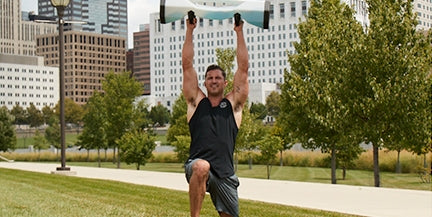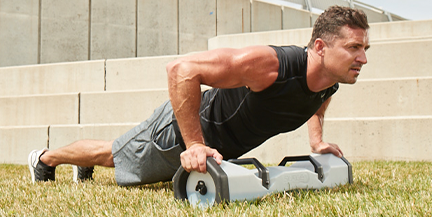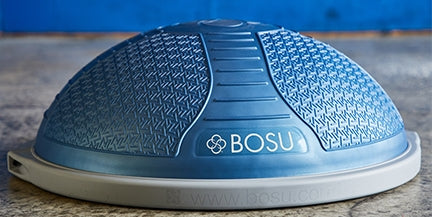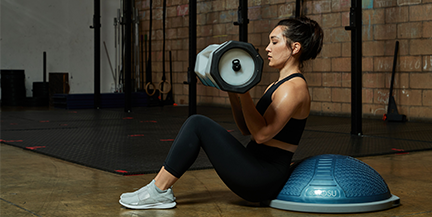Give Your Barbell a Rest Day

Even if you don’t use a barbell -- give your go-to routine a rest. Your body needs it as much as your mind. Plus, periodization (cycling volume, intensity and exercise variety over specific time periods) and accessory training are key to crafting a completeapproach to your conditioning program. An effective program continually provides new gains, improves performance and has a role in injury prevention.
All of us who coach are constantly investigating new ways to help our athletes get better every day. But, just as important, the methodology -- in this case, utilizing Hydro-Inertia™-- must be worth the time invested with regard to overall results and training outcome. If you’re searching for another piece of the training puzzle, you’re on the right track.
The Holy Grail
Most trainers would agree that the Holy Grail of performance and physical capability requires the pursuit of body control, balance and stabilization. However, these qualities must be sustainable and expressed while exerting high levels of power, strength and speed.
In lieu of this unending pursuit, dynamic water training tools, such as the SURGE® Storm, have become a staple of athlete conditioning programs.
Barbells, Dumbbells and Water
The big difference between static load (e.g., dumbbells, kettle bells, weight plates, barbells) and dynamic load (e.g., SURGE® Storm) are the reactive stabilization requirements that occur when using the volatility and unpredictable nature of water. Don’t get me wrong here. Research clearly supports stabilization improvements when “lifting heavy things.”
However, water as a resistance tool supplies a continually shifting, never-the-same stimulus the body must react and adapt to on a continual basis. In essence, you turn stabilization on and off as needed, and that is what is required to perform well and avoid injury in both sport and life. Again, you don’t throw out your free-weights and barbells, you simply accessorize your training with this new and different type of training of which your body and brain don’t get enough!
When using water, force production and stabilization requirements are high, even though the relative water load, in an absolute sense, might be less. In other words, 20 lbs. of water load may require more on/off stabilizing force production when compared to a heavier, fixed load such as a 40 lb. dumbbell. An unstable, constantly changing load -- think static vs. dynamic load -- can increase maximal muscle recruitment for a given load, and improves motor control and stability.
It is critical that you understand fixed stable-load force production vs. unstable-load force production to value this approach. By introducing a new overload variable that the body must continually adapt and respond to -- reactive instability training using water -- it becomes apparent there is a difference between static and dynamic loading. That means that a SINGLE type of training does not cover you, or your athletes’, training bases. Accessory exercises with dynamic and reactive water-load can help increase static load capability! Simply put, your power and strength capacity can increase when you integrate dynamic load accessory training with traditional static-load (barbells, weight plates, dumbbells) training.
Water Actions
Dynamicresistance can be experienced via unintentional disturbances in balance and stabilization, and/or by purposeful manipulation of water action that creates specific stabilizing and neural responses to the instability of water.
1. Quiet:No water motion. During movement, constant feedback is necessary to neutralize any water movement. Ongoing self-correction improves stability imbalances.
2. Crash: Acceleration of the water with a quick stop. Water crashing requires hard, quick on/off stabilizing muscle contractions to control the crashing water.
3. Oscillate: Continuous water motion. Constant water motion reinforces stabilization of the core and time under tension.
4. Dump: Shifting water from one end of the SURGE® Storm to the other. Intense bracing and stabilization are required at end range of motion.
Experience the Storm!
In these exercise clips, I’m using the SURGE® Storm 40 at a weight of 20 lbs., which is 50 percent of its max weight of 40 lbs. The SURGE® Storm 60 weighs out at a max of 60 lbs. Note, that as you reach maximal fill capacity, reactivity goes down. To train optimal power, reactivity and stabilizing forces, less-load is often more. Concentrate on speed of movement, control, and stabilization.
SURGE® Mobility Squat to Rotary Press
From standing with feet in wide athletic stance, hold the SURGE® Storm in neutral grip in front of the chest. Lower into a squat, then slowly shift right and left. Press back up to standing, pivot the feet, and simultaneously rotate the torso and press the SURGE® Storm overhead to one side. Keep the SURGE® Storm level and the water quiet throughout the exercise.
SURGE® Hang Clean to Overhead Thruster
From standing with feet in hip width athletic stance, hold the SURGE® Storm in neutral grip in front of the legs. Hinge forward slightly, then pull the SURGE® Storm to a clean catch at the shoulders. Thrust the SURGE® Storm overhead and pull back to the start position, crashing the water at both the top and bottom of the thruster.
SURGE® Pole Lift to Shoulder Throw
From standing behind the SURGE® Storm in athletic stance, with neutral handles facing in, place the hands in pressure grip below the end caps. Squat and lift the SURGE® Storm with 3 quick tosses upward, then lift to shoulder carry position. Arc the SURGE® Storm over the head 3x, finishing on the opposite shoulder. Lower to start position on the floor. Maintain stability as the water oscillates.
SURGE® Core Tuck with Vertical Water Dump
From seated in a v-sit position, hold the SURGE®Storm in neutral grip in front of the chest. Extend from v-sit to supine and back to v-sit. Tip the SURGE® Storm to vertical on one side of the body, pausing and stabilizing as the water dumps. Arc the SURGE® Storm to vertical on the other side, letting the water dump before returning to start position.
The SURGE® Storm is NOT a Barbell, Dumbbell or Slosh Pipe
To be clear, what we don’t want is a 40 lb. “water-barbell,” which happens if you fill the SURGE® Storm 40 to capacity. We’ve already got static-weight in the training room in the form of kettle bells, barbells, and dumbbells. To achieve a new and useful training effect, keep the dynamic reactivity of the water actions by NOT filling the SURGE® Storm 40 or 60 to its limit.
Additionally, many of us have used homemade slosh pipes or tubes, and you know from experience that when the water shifts in a pipe, it is an all-or-none cascade of water that is often too much to safely control. The chamber design of the SURGE® Storm modulates the flow of water to a more controllable and progressive reactivity experience that translates well to sport or activities of daily life. Also, its design features (e.g., end caps, different grips) greatly enhance utility. Bottom line, the SURGE® Storm is NOT just a pretty slosh pipe!
4-Reasons To Use Water
1. Hydro-Inertia™ Training enhances the development of balance, stability and reactivity, which can lead to increased load capability when performing traditional strength training exercises. That fact should keep your attention!
2. Hydro training or training with the dynamic loading of water, should become a part of your training approach to help develop the physical capability to support skill execution at any level of fitness.
3. Hydro Training optimizes a variety of loading strategies for both resistance and proprioceptive challenge.
4. A completeapproach to training impacts strength acquisition and movement skill development because attainment of muscular control influences stability, mobility, balance and positioning. Hydro training should play an important role in attainment of this outcome.
Mindset And Training Culture -- Another Piece Of The Puzzle
We can’t talk results without understanding the importance of an optimal training environment and culture. Equipment and methodology can only go so far.
You, and/or your athletes, need to be supplied with the right tools and tactics (e.g., progressions, cues, equipment, methodology), but make sure you and your athletes, understand how you get there and how to become solution-oriented at a personal level -- you become a critical thinker and problem solver -- to stay on track for continued improvement.
Not only do you need to utilize innovative training methods that work, but the training culture you create is critical. It is captured by the following mindset as it relates to skill repetition and practice.
This mindset in its most simple form: Fail, fail again, fail better! It is essential to remember that refining skills requires patience and consistency over long periods of time, as well as innovative training that provides a training edge.
Change how you think and how you practice! Own it!
There are two ways to do something…
“The right way, and again.”Navy SEAL quote
“Don’t practice until you get it right;
practice until you can’t get it wrong!”Source Unknown
Now, “Just add water!” to help complete your training approach.
Douglas Brooks, M.S., Exercise Physiologist, is Director of Programming for SURGE® and specializes in sport conditioning and strength training
Learn, train and engage with other fitness professionals at SURGE® Live Education courses. For information on our cutting edge content, taught by the best in the industry, click HERE.
References (partial list)
Glass, SC, and Albert, RW. (2018) Compensatory muscle activation during unstable overhead squat using a water-filled training tube. Journal Strength Cond Res 32(5): 1230–1237.
Glass, SC, Blanchette, TW, Karwan, LA, Pearson, SS, O’Neil, AP, and Karlik, DA. (2016) Core muscle activation during unstable bicep curl using a water-filled instability training tube. Journal Strength Cond Res 30(11): 3212–3219




